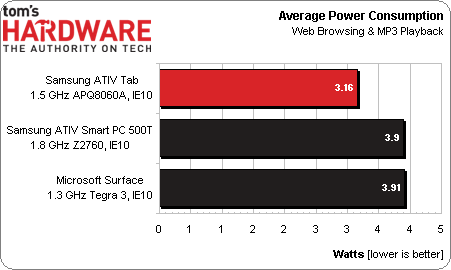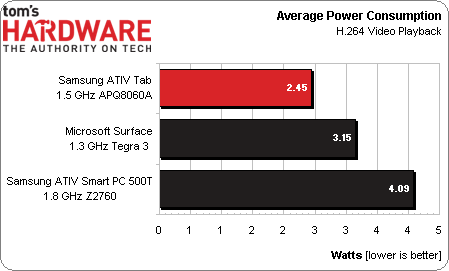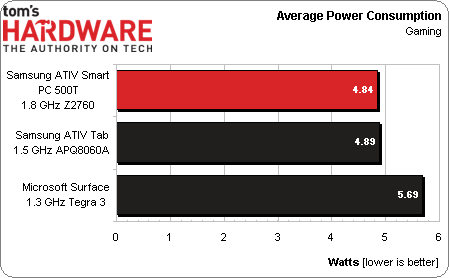Samsung ATIV Tab Review: A Tablet To Hold Your Breath For?
Microsoft set the standard for Windows RT-based hardware, but is there still room for partners to sell compelling alternatives? We take our first Qualcomm-powered Windows RT tablet for a spin to determine if Samsung's ATIV Tab is worth waiting for.
Getting To The Bottom Of Platform Power
Could SoC vendors build higher-performance hardware better able to cut through more taxing tasks? Absolutely. But in this space, power consumption is more important than performance. Even a 1 W difference in total platform power use can mean hours of battery life. That's why you've seen us go into more depth dissecting consumption lately in ARM Vs. x86: The Secret Behind Intel Atom's Efficiency and Update: Intel Expands Our Battery Testing At CES 2013.
The results presented in those two links were generated by feeding identical workloads through tablets based on different SoCs, and then recording power figures from physical connections to power planes on the bare circuit boards. Here, we're working backward from our battery life numbers using the following formula: Watts (W) = Battery Capacity (Wh) / Battery Life (in time [h]).
Of course, we're unable to compare Tegra 3 to APQ8060A to Atom Z2760 directly this way, since each tablet uses a different display that also factors into the equation. But we've attempted to create as fair a comparison as possible by calibrating each screen to 200 nits and using the latest firmware/drivers.
Keep in mind, though, that battery life and power consumption comparisons are very situational. In Chris Angelini's story from CES 2013, he pointed out that the workload you apply to each SoC affects power use in a different way. So, the numbers we have here are applicable to the very specific sequence of spending six minutes reading a certain Wikipedia entry, reloading, and listening to constant MP3 audio playback. That's not very intensive. Also, device optimizations are critical. A simple update to the ATIV Smart PC 500T's firmware yielded around 10% greater battery life, for example. Finally, Nvidia points out that features like its PRISM technology also affect battery life, making it doubly important to be totally transparent when we talk about workloads and granular measurements of core, graphics, and display power use.
We've already established that Intel's x86 ISA indeed holds its own against ARM-based SoCs when it comes to efficiency. Even though these average wattage numbers don't come from a logger hooked up to each tablet's battery, the Qualcomm and Nvidia numbers are still impressively close to what Angelini reported from CES. The ATIV Smart PC 500T sits in the middle of the field, higher than what I might have expected given Chris' measurements. Remember, though, that Intel put a lot of effort into optimizing the Iconia W510 featured in the company's suite. The 500T doesn't seem as aggressively tuned for low power consumption.
With all of that said, we see that the dual-core, 28 nm APQ8060A-equipped ATIV Tab uses less power than the Tegra 3-based Surface, all variables (such as the display) included.
The finishing order of this workload is exactly the same as what Chris measured using logging equipment, though the numbers themselves differ a bit. In both cases, he and I used a H.264-encoded copy of Iron Man. Our ATIV Tab results match up almost identically. The Smart PC 500T uses a little more power than his Iconia W510 (again, expected, given Intel's optimizations to the Acer tablet). And my Surface looks more power-friendly than what he measured by about .17 W.
Get Tom's Hardware's best news and in-depth reviews, straight to your inbox.
In both sets of benchmark numbers, Samsung's ATIV Tab uses the least amount of power playing back our movie workload. Given a comparably-sized power source, this should manifest itself on the next page as superior battery life from the Tab as we drain it with Iron Man, looped.
When it comes to gaming, Tegra 3's eight pixel shaders and four vertex shaders can't handle Vector Unit's Riptide GP more efficiently than the Adreno 225 or PowerVR SGX545 engines. What about the games optimizations for Nvidia's SoC? The developer disables detection under Windows RT, so all three architectures are forced to content with the same more-demanding effects. Score a win for Intel on this one. How is this possible?
While we were at CES, however, we met up with Lazslo Kishonti, CEO of Kishonti Informatics and the developer of GLBenchmark. He pointed out that Atom-based tablets running Windows 8 are more likely to deliver different levels of performance. Imagination Technologies writes its own drivers and supplies them to its partners. Because Intel has certain requirements that Imagination is not willing to satisfy, however, Intel writes its own software for the PowerVR core.
Factoring Out The LCD
This analysis thing is like a drug, and we wanted more. So, we thought we'd output to an external display and shut off the tablet's panel, effectively removing it from our power measurements (an exercise only possible under Windows 8 and RT). Although this limits the number of tablets we're able to compare, we really wanted to see how the results would change.
Our setup is pretty basic: we set BrowsingBench to run in battery life mode, which prevents the browser from caching data. Instead of running through as quickly as possible, operations are executed at user-time, in real-world speeds. In addition, the benchmark pauses on sections of a webpage to simulate reading time.
| Tablets | Samsung ATIV Tab(Qualcomm APQ8060) | Samsung ATIV Smart PC 500T(Intel Atom Z2760) | Microsoft Surface(Nvidia Tegra 3) |
|---|---|---|---|
| Battery Capacity | 30.75 Wh | 30.75 Wh | 31.5 Wh |
| Internal Panel | 2.75 W | 3.84 W | 3.31 W |
| Output to 1080p Monitor | 0.77 W | 2.79 W | 1.58 W |
| Difference Attributed To Internal Panel | 1.98 W | 1.05 W | 1.73 W |
We'd really like to log the power use of BrowsingBench with fully-instrumented tablets to confirm the data in our table. But it looks like bypassing the Tab's 10.1" display sheds nearly 2 W of power consumption, on average, as the benchmark runs, looped. Let's quantify this a little: after two hours of outputting its display signal to an external screen, the ATIV Tab's 30.75 Wh battery only drops 5%. The Surface's larger 31.5 Wh battery drops between 10 and 11% (we ran this three times to be sure).
Samsung's Smart PC 500T remains difficult to explain, as its externally-output power number looks a lot higher than we'd expect.
Current page: Getting To The Bottom Of Platform Power
Prev Page Performance: IE10 And Multi-Monitor Browsing Next Page Battery Life And Recharge Time-
kyuuketsuki ReplyWhile we were at CES, however, we met up with Lazslo Kishonti, CEO of Kishonti Informatics and the developer of GLBenchmark. He pointed out that Atom-based tablets running Windows RT are more likely to deliver different levels of performance.
Er, you mean Atom-based tablets running Windows 8? (Page 6, Paragraph 11)Power consumption graphs says this tablet has Z2760.Our setup is pretty basic: we set BrowsingBench to run in battery life mode, which prevents the browser from caching data. Instead of
Where's the rest of this paragraph? (Page 6, Paragraph 13) -
kyuuketsuki Also, I'm not sure what's up with the Futuremark Peacekeeper and Rightware Browsermark results, but we know damn well the Krait S4 in this tab is a better performer in every way to the Tegra 3. Not sure why go with the S4 Play with the dual-core Krait and Adreno 225 instead of an S4 Pro with quad-core Krait and Adreno 320, though, especially in a tablet form-factor.Reply -
mayankleoboy1 KyuuketsukiNot sure why go with the S4 Play with the dual-core Krait and Adreno 225 instead of an S4 Pro with quad-core Krait and Adreno 320, though, especially in a tablet form-factor.Because Win8 is already a battery hog compared to Android, and adding power hungry cores will make that worse.Reply
I dont see any issues with S4 pro and Android. -
cangelini KyuuketsukiEr, you mean Atom-based tablets running Windows 8? (Page 6, Paragraph 11)Where's the rest of this paragraph? (Page 6, Paragraph 13)Fixed!Reply -
dokterprio Why there is difference in power usage between ativ tab and ativ smartpc 500t. I think they are the same, except the screen size.Reply -
adamovera dokterprioWhy there is difference in power usage between ativ tab and ativ smartpc 500t. I think they are the same, except the screen size.Sorry, we had the charts labelled the same. The ATIV Smart PC 500T has an Atom and runs Windows 8, while the ATIV Tab has an ARM-based chip from Qualcomm and runs Windows RT - they are actually very different devices.Reply -
adamovera ojasBrowsingBench scores: are the ipads in correct order?Seems to be, I haven't used this benchmark yet myself, and I'd have to check with the author to be sure, but I'd guess that these results are inversely reflecting the resolution of the different iPads.Reply



